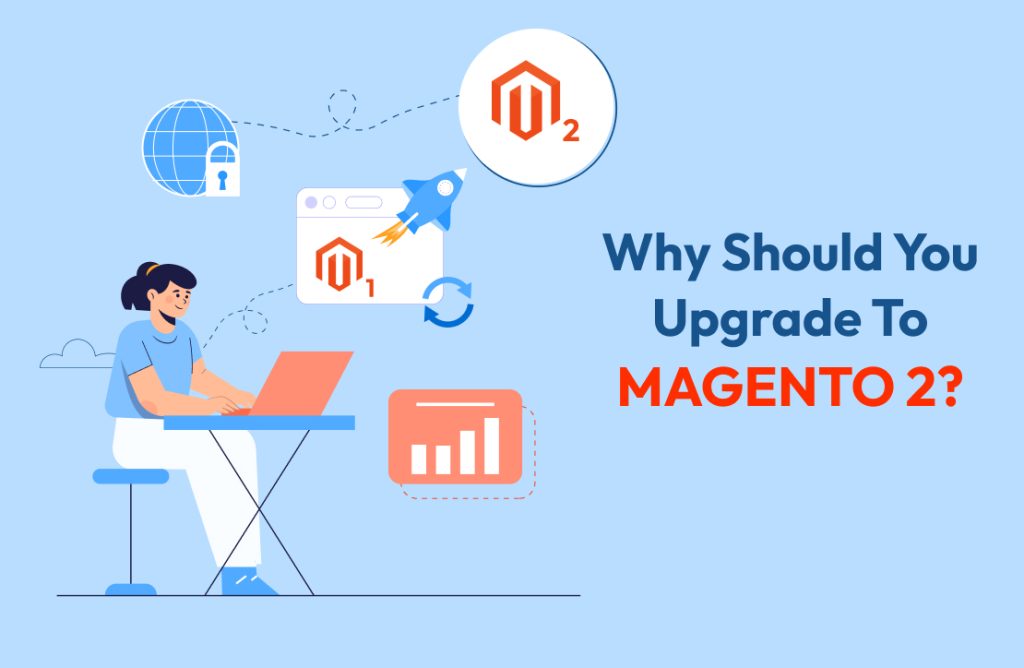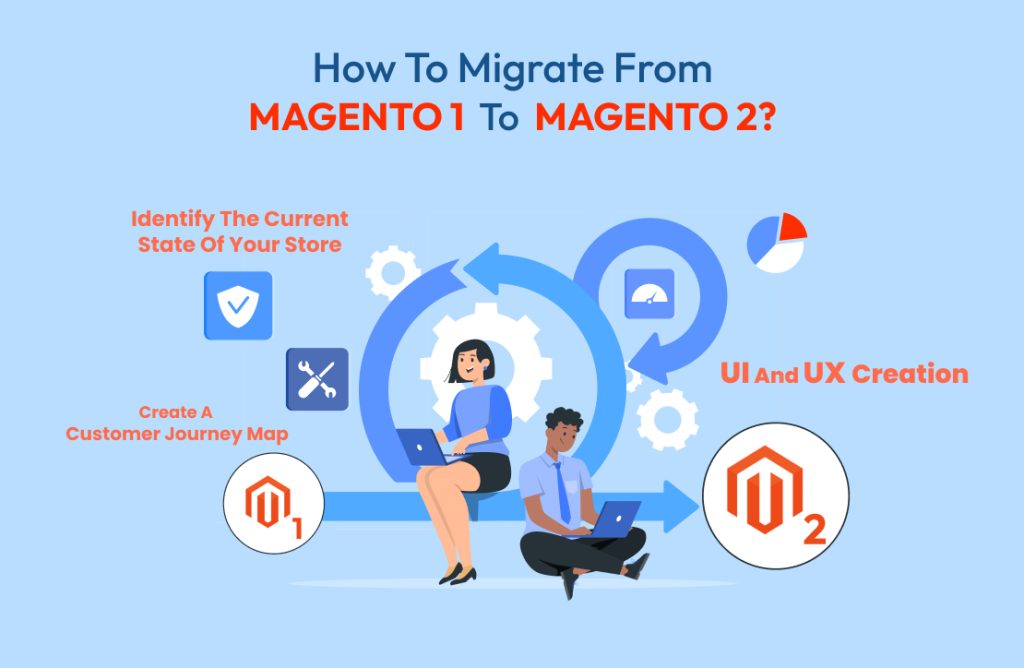Magento stopped supporting Magento 1.0 in 2022. However, many businesses still use the platform to run their e-commerce stores, which can lead to many security, performance, and update challenges.
It is high time you considered Magento 1 to Magento 2 migration if you are serious about growing your business and ensuring impressive user experiences.
Of course, migrating to Magento 2 from Magento 1 can be time-consuming and challenging. And it would be hard to do without the help of a Magento development agency.
In this post, we explain all you need to know about migrating to Magento 2 from one as seamlessly as possible.
As the guide is extensive, we have divided it into 2 parts. This is the first part.
Why Should You Upgrade to Magento 2?
Despite knowing that the support for Magento 1 has ended, you may have good reasons to still stick with Magento 1. However, did you know that Migrating to Magento 2 can help your business even better?
While Magento 2 has significant improvements, such as higher performance, better security, etc., the new architecture makes it exceptional.

It offers better store performance.
When developing Magento 2.0, the developers paid much attention to making it considerably better than its predecessor. The result is a high-performance website in all aspects.
The load time has increased significantly, which improves user experience and conversion rates. As the site is more responsive, it also works incredibly well on mobile and hand devices.
It assures better security.
One of the significant developments happened in the security department of the platform. With new and improved security features, you can confidently thwart cyber threats against your store.
Magento 2.0 has highly advanced data encryption and secured payment gateways, making users confident about your site’s payments.
It also does an excellent job against SQL injection and XSS attacks.
It offers a better user experience.
The latest version of Magento offers a better user experience for your customers. As it is more intuitive, users can easily navigate and find what they’re looking for.
This can lead to increased engagement and higher conversion rates.
A better user experience will also help you in Search Engine Optimization, as search engines reward stores with better user experience and longer sessions.
It delivers greater flexibility.
Magento 2 is more flexible than its predecessor.
The all-new, improved admin panel makes managing your store easy. Further, the platform is more customizable, and you can create a unique look and feel for your website aligning with your overall brand voice.
This helps you create a unique identity for your store and stand out from the competition.
How to Migrate from Magento 1 to Magento 2?
Migrating to Magento is a challenging and time-consuming process. Approaching the migration process strategically and with a thorough plan is your best way to ensure a smooth migration.

The process requires the support and full collaboration of a range of technicians and experts, such as a project manager, Magento 2 expert, designer, QA engineer, etc.
There are multiple phases in Magento migration.
Let’s try to understand each of them here:
Pre-Migration Planning
Before you begin the migration process, plan it carefully to ensure everything runs smoothly. This helps us understand the challenges ahead to plan the same.
Here are some essential steps to take:
Step #1: Identify the current state of your store
You need to assess the current state of your store and identify any potential issues that could arise during the migration process.
This includes:
- Taking a backup of your store’s data
- Checking the version of Magento, you are currently using
- Identifying any customizations or extensions you have installed
- The functional updates you need to make during the migration
After evaluating these elements, you can understand the current technical setting and the scope of the project at hand.
This is an important aspect of the migration process as it helps you prepare for the same.
Step #2: Create a customer journey map
The intent of migrating your Magento store to the latest version is to deliver the best user experience for your users. Hence, understanding it is crucial.
This is the next thing you need to do.
You need to create a visualization map to help you understand your customer’s experience with your website.
Once you have mapped the journey, you can understand what the customer goes through when they interact with your store. There will be a ton of insights as to where they have the best experience and where they are not.
The idea is to use the insights to create a smoother and more consistent experience across multiple touchpoints in your store.
When you develop the journey, the following elements are the most crucial inclusions:
- Your ideal customer persona
- Your customer’s lifecycle in your store
- Customer touchpoints in your store
- Your customers’ pain points
- Strategies to resolve the users’ pain points
Some businesses ignore this part of their migration process. However, this critical stage helps you ensure a smooth migration.

Step#3: UI and UX Creation
According to your custom requirements, there are three ways you can go about the UI and UX of the store when migrating from Magento 1 to Magento 2.
Let’s try to understand each of these options here:
- Option 1: Migrating the old design with no changes
This is the best route to save time and complete migrating to Magento 2 quickly. From a user experience standpoint, this is not the best option.
The UI and UX of Magento 2 have changed a lot since Magneto 1.
Therefore, sticking to an older design can create user experience gaps in the latest version.
Going with a newer design that takes full advantage of the UX capabilities of Magento 2 is the best option.
- Option 2: Customize a Magento theme
You can find many ready-made Magento themes on the platform.
When migrating, you can easily switch to any of such themes from an older design. Magneto Marketplace and Theme Forest have a wide variety of Magento 2 themes you can choose from and customize.
Using a theme can considerably reduce your migration time as you don’t have to design the look and feel of the store. It is also a more affordable option.
Remember that template themes are not the best for your store’s performance. They can slow down your site and compromise the user experience.
- Option 3: Create a new design for the store
Many expert Magento migration agencies, including AddWeb Solution, recommend creating a new design for your store when migrating to Magento 2.
The reason behind migration is to create a unique user experience and ensure top performance from your site. This won’t be possible without a custom design for your store.
Moving your store to Magento 2 is quick and effortless without a new design.
That cannot be farther from the truth. Compared to migrating to the old design and maintaining the same, the effort and cost involved in creating a new design for the store are almost the same.
Creating a new design will also help you make your store more user-centric and address the specific pain points of your customers.
So, what steps are involved in designing a new look for the store?
Designing a new look for your Magento 2 store depends on the changes you want to make to your existing website.
In a nutshell, the following steps are involved in designing the new store:
- Evaluate the existing store’s UX and understand the gaps in the user experience.
- Learn about all the UI issues, explore the limitations of the existing sales funnel, and update it.
- Create detailed wireframes for multiple platforms like desktop, mobile, and tablet.
- Vet the existing store and content structure to make adequate changes to the same for all three technology environments.
- Assess the existing navigation and its logic to make it better for easy and simple site exploration on all three technology environments.
- Consult with the development team to ensure that the design elements align with the performance and development goals of the store.
The planning stage for Magento 1 to Magento 2 migration is complete with these steps. Let’s discuss the same in the next part of the guide. Read the next part of the Magento Migration blog here.
Frequently Asked Questions
Migrating to Magento 2 offers improved performance, enhanced security, better user experience, and access to new features. It’s a crucial step to stay updated with technology and ensure long-term support for your online store.
Yes, Magento 1 reached its end of life in June 2020, meaning it no longer receives official support and security updates. Migrating to Magento 2 is essential for maintaining a secure and sustainable e-commerce platform.
Magento 2 offers faster page loading, improved scalability, a more user-friendly admin interface, advanced security features, and a better overall performance compared to Magento 1.
Planning involves assessing your current Magento 1 store, identifying customizations, preparing a data migration strategy, and creating a timeline. It’s crucial to plan thoroughly to ensure a smooth transition.
Pre-migration steps include creating a backup of your Magento 1 store, documenting custom features, extensions, and themes, and evaluating your current data structure to identify any potential challenges.
While Magento 2 uses a different theme structure, you can migrate your design elements. However, it’s advisable to consider updating the theme to take advantage of Magento 2’s improved design capabilities.
Identify Magento 2 compatible versions of your existing extensions or seek alternatives. Custom extensions may need to be modified or rebuilt to align with Magento 2 standards.
Data migration involves transferring customer data, product information, orders, and more. While it can be complex, Magento provides tools to assist in the process. Careful planning and testing are crucial for a successful data migration.
Post-migration tasks include thorough testing of the new site, updating DNS records if the URL has changed, and monitoring for any issues. Regularly check for updates, and consider implementing additional features available in Magento 2.

Start Your Migration Journey – Follow the steps to seamlessly transition to Magento 2 today.

Pooja Upadhyay
Director Of People Operations & Client Relations

